WHAT'S NEW ACROSS THE WORLD
What's
new April 2000
What's
new July 2000
What's
new October 2000
What's
new January 2001
What's
new April 2001
What's
new July 2001
What's
new October 2001
What's
new January 2002
What's
new April 2002
| What's New ©by
Laif DeMason
As summer wears on, cichlid hobbyists adjust their
activities to encompass other fair weather interests. The previous
past few months have seen diverse but active interests in a wide range
of species. Interestingly, several “out of favor” species, which
normally sit on the shelf for months, have suddenly been snapped up by
customers. This leads me to believe that hobbyists are constantly
branching out to experiment with forms that they aren’t currently keeping.
Today, cichlid hobbyists have been especially bombarded with hyper-sales
pitches from sellers’ web pages. Unfortunately, many buyers have
found that they certainly will not get rich by listening to promoters’
opinions. All of which lends well to the current trend: buy
what YOU like!
Here’s “what’s new” on the cichlid scene: |
Lake Tanganyika
Collections have been brisk along the Zambian and Tanzanian coasts of
Lake Tanganyika. Congo has cracked open its doors to those who pay heavy
entry bribes. While cichlid inventories are up, exporters complain about
marginal shipments. Certainly in Zambia, it would be hard to believe that
all six current exporters can actually have enough business to survive
over the next year..
|
what's new: Lake Tanganyika
|

Reportedly from Kampampa (Congo), this new version
of Julidochromis marlieri sports a blotchy body pattern. |
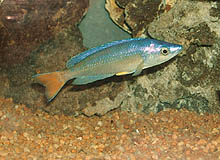
This particularly strikingly-colored Cyprichromis
leptosoma is from Bulu Point (Tanzania). |
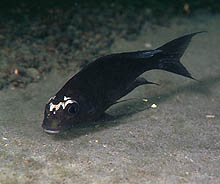
Out-of-the-norm featherfins, like this Opthalmotilapia
ventralis “Sibwesa,” have peaked hobbyists interests. Photo by
A. Konings. |
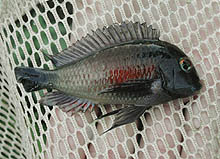
Reportedly from Zambia, an intermediate variety, Tropheus
moorii “red sunspot” has arrived on the scene. |
Lake Malawi
Currently there seems to be at least seven collectors on Lake Malawi
between Tanzania and Malawi. Again, it is difficult to see how all of them
can succeed. Some don’t even have permanent facilities to keep their
fishes! Hapless importers who fall into the trap of ordering from these
exporters will certainly encounter problems with their shipments. Infrequent
collections in Mozambique and other restricted reserve areas still occur.
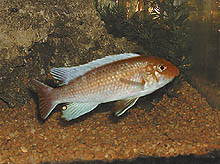
From Pombo Reef (Tanzania), Labeotropheus trewavasae
sports an orange head and body markings. |
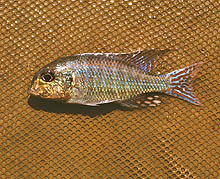
Several Lethrinops varieties, such as L.
marginatus, have been received recently from Tanzania. Photo
by C. Kacirek. |
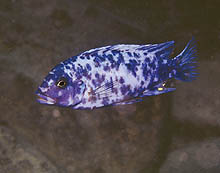
One of the “marmalade cats”, this male Metriaclima
zebra from Manda (Tanzania) has an interesting “blueberry” pattern. |
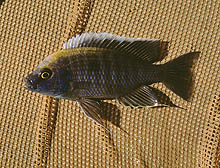
Exported from Tanzania, a Copadichromis virginalis
marked with a gold and white blaze is sold as “daisy cap”. Photo
by C. Kacirek. |
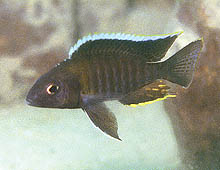
From the National Park near Thumbi East (Malawi),
Aulonocara sp. “yellow collar” has been imported again. Photo
by A. Konings. |
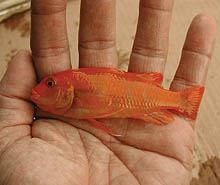
Selected from an OB strain of Metriaclima estherae,
this albino red OB zebra is a strikingly colored fish developed in Florida. |
Victoria
While no new imports have been reported from the Victoria basin, different
color morphs developed by breeders appear from time to time. These
new developments often give Victorian cichlid enthusiasts something novel
to keep.
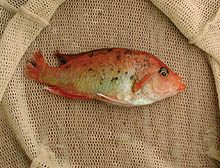
A new morph selected from a Ugandan piebald haplochromine,
this florescent pink form lacks black markings for the most part, but sports
a yellowish flank. |
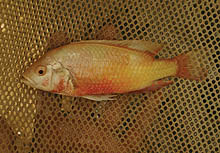 Mutated naturally from wild-type stock, this albino Astatotilapia latifasciata,
also known as “albino zebra obliquidens”, holds promise.
Mutated naturally from wild-type stock, this albino Astatotilapia latifasciata,
also known as “albino zebra obliquidens”, holds promise. |
Neotropics
As more and more hobbyists travel to both Central and South America,
interesting varieties of cichlids and habitats are found. These travelers
also learn the interrelationships within these fishes’ natural communities
and thus branch out into other groups of fishes. Will we see a re-birth
of the community aquarium?
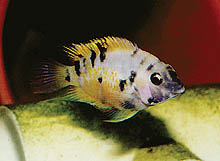
A new color morph of Archocentrus nigrofasciatus
is known as the “calico convict.” Photo by J. Rapps. |

Apistogramma cacatuoides “gold double red”
is a new color strain available from European breeders. |
|











 Mutated naturally from wild-type stock, this albino Astatotilapia latifasciata,
also known as “albino zebra obliquidens”, holds promise.
Mutated naturally from wild-type stock, this albino Astatotilapia latifasciata,
also known as “albino zebra obliquidens”, holds promise.
